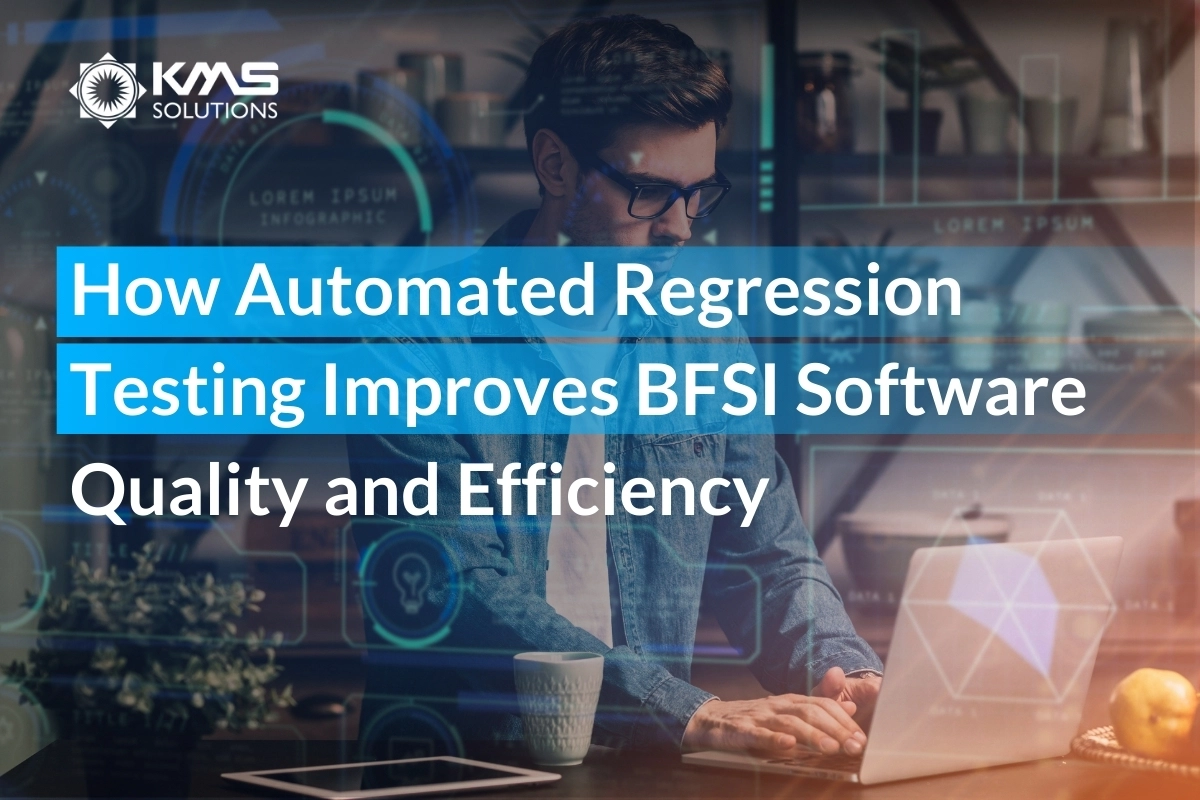In the fast-paced world of BFSI, where every transaction counts, software quality and efficiency are paramount. Traditional manual regression testing, while essential, can be time-consuming and error-prone. This is where automated regression testing comes into play.
Automated regression testing has emerged as a powerful solution to ensure that software updates and enhancements do not compromise existing functionalities. Reading this article to discover the strategic role of automated regression testing and how KMS Solutions can help your organization achieve consistent, high-quality software performance.
1. Understanding Automated Regression Testing
1.1 What is Automated Regression Testing?
Automated regression testing involves creating and executing automated test scripts to ensure that recent software changes haven’t caused any unintended side effects. These changes might include enhancements, patches, configuration changes, or other modifications.
During this process, test scripts are used to mimic user interactions with the application, focusing on essential functionalities and core workflows critical to the user experience.
Compared to manual testing, automated regression testing offers several benefits, particularly in continuous testing scenarios. With automated regression testing, you can:
- Eliminate the need for manual execution of test cases
- Save time and resources throughout the software development lifecycle
- Minimize the risk of human error affecting test results
- Integrate testing seamlessly into the development pipeline
- Increase test coverage by running more tests across various scenarios and platforms, ensuring comprehensive application testing.
- Identify and address issues better by faster feedback loops that provide quick results identify and address issues faster.
- Improved accuracy and consistency as automation ensures the same execution every time, reducing variability and enhancing reliability.
1.2. Difference Between Automated Regression Testing and Retesting
When it comes to ensuring software quality, understanding the distinction between automated regression testing and retesting is crucial. Though both testing methods are essential, they serve different purposes within the software development lifecycle. Here’s a breakdown of the key differences:
Automated Regression Testing | Retesting | |
| Purpose | Ensures that recent code changes haven’t negatively impacted existing functionalities. | Verifies that previously identified issues have been successfully fixed. |
| Focus | Focuses on confirming that new updates or enhancements haven’t introduced new bugs. | Focuses on verifying specific test cases that previously failed due to defects. |
| Scope | Performed after updates or enhancements to ensure overall system stability. | Narrow, targeting only the particular areas or test cases where defects were initially found. |
| Execution | Performed after updates or enhancements to ensure overall system stability. | Performed after a bug fix to ensure the specific issue has been resolved. |
| Test Cases | Includes a comprehensive set of test cases, often automated, that check multiple functionalities. | Involves re-executing the same test cases that previously failed to verify their success. |
| Outcome | Identifies any unintended side effects of new changes, ensuring that the application remains functional. | Confirms that the specific defects have been addressed and no longer occur. |
- Automated Regression Testing: This is a systematic approach that checks whether recent code changes have adversely affected the existing features of an application. It’s crucial for maintaining software stability and is typically executed after any significant update or enhancement.
- Retesting: This is a more targeted process where specific test cases that previously failed are run again after the defects have been fixed. The primary goal is to verify that the identified issues have been resolved effectively.
In essence, while automated regression testing is about safeguarding against new bugs, retesting is about ensuring that known issues have been fixed. Both are critical in delivering a robust, bug-free software product.

2. Benefits of Automated Regression Testing in BFSI
2.1 Enhanced Efficiency and Speed
Automated regression testing dramatically accelerates the testing process. Tests that would take days to perform manually can be completed in just hours or even minutes, allowing for the rapid identification of issues and faster release cycles. This efficiency is crucial in the BFSI sector, where timely updates and responsiveness to market changes are critical.
2.2 Consistent and Reliable Testing Results
One of the primary benefits of automated regression testing is its ability to produce consistent and reliable results. Unlike manual testing, which can be prone to human error, automated testing provides uniform results across test cycles. This consistency helps in accurately identifying issues and ensures that every test run delivers trustworthy data, thereby maintaining the integrity and quality of BFSI applications.
2.3 Early Detection of Bugs and Issues
With automated regression testing, continuous testing becomes feasible, allowing for the early detection of bugs and issues. Identifying these problems early in the development process reduces the cost and effort associated with fixing them later. For the BFSI sector, where even minor glitches can lead to substantial financial losses or compliance risks, early bug detection is critical for maintaining operational stability and customer trust.
2.4 Cost-Effectiveness in the Long Run
With automated regression testing, continuous testing becomes feasible, allowing for the early detection of bugs and issues. Identifying these problems early in the development process reduces the cost and effort associated with fixing them later. For the BFSI sector, where even minor glitches can lead to substantial financial losses or compliance risks, early bug detection is critical for maintaining operational stability and customer trust.

3. Key Strategies for Effective Automated Regression Testing
3.1 Prioritize Test Cases
In automated regression testing, prioritizing test cases is vital for efficient resource use and timely results. Focus on test cases that cover core functionalities, high-risk areas, and frequently used features. By ranking these critical components first, you ensure that potential issues are quickly identified and resolved, maintaining the software’s stability and reliability.
3.2 Utilizing Robust Testing Frameworks and Tools
Choosing the right tools and frameworks is crucial for successful automated regression testing. Tools like Katalon Studio, Jenkins, and TestNG offer robust features for BFSI applications. KMS Solutions leverages these advanced tools to deliver top-notch automated regression testing services tailored to the BFSI sector.
3.3 Integration with CI/CD Pipelines
Integrating automated regression testing with Continuous Integration and Continuous Deployment (CI/CD) pipelines ensures that tests are run automatically with every code change. This integration provides immediate feedback and allows for continuous improvement.
3.4 Regularly Updating Test Cases
Test cases must be regularly updated to reflect changes in software requirements and functionalities. Gather feedback from developers, testers, and stakeholders to refine your testing strategy. This practice ensures that the tests remain relevant and effective in detecting issues.
3.5 Optimize Test Scripts
To enhance the efficiency and maintainability of your automated regression testing, create independent and robust test scripts that are modular, reusable, and adaptable to changes. Breaking down large test scripts into smaller, manageable modules enhances reusability and simplifies maintenance. This approach ensures that scripts can be updated and managed easily as the software evolves, reducing time spent on debugging and modifications.
Additionally, executing test cases in parallel can drastically reduce execution time, especially for larger test suites. This strategy allows for faster feedback loops and quicker identification of issues. Regularly reviewing and refining test scripts is equally important to maintain their effectiveness and performance. As requirements change, it’s necessary to update test cases, ensuring they align with the current software architecture and features.
Independent test scripts ensure that each test can be executed without relying on the outcome of another, reducing the risk of cascading failures and enhancing reliability. By following these optimization strategies, teams can significantly improve the robustness and efficiency of the regression testing.

4. Tools for Automated Regression Testing
4.1 Overview of Popular Tools
Popular tools for automated regression testing include Selenium, Katalon Studio, SoapUI, and Appium. Each tool has its strengths and is suited for different testing needs within the BFSI sector.
| Benefits | Key Features | Pricing | |
| Selenium |
|
| Free |
| Katalon Studio |
|
| Free and Paid plans (starting at $759/year) |
| SoapUI |
|
| Free and Pro plan (starting at $599/year) |
| Appium |
|
| Free |
| Playwright |
|
| Free |
4.2 Choosing the Right Tool for BFSI Applications
Selecting the right tool for automated regression testing, especially within the BFSI sector, requires a careful evaluation of several critical factors. These factors ensure that the tool not only meets the technical demands of the project but also aligns with the unique requirements of BFSI applications.
- Ease of Use: The tool should have a user-friendly interface that allows testers and developers to efficiently create, execute, and manage test cases. This is crucial for teams with varying levels of expertise, ensuring that the tool can be adopted quickly without a steep learning curve.
- Integration Capabilities: The chosen tool must integrate seamlessly with existing development and CI/CD pipelines. This includes compatibility with popular tools like Jenkins, Jira, and various source control systems, allowing for a streamlined workflow that enhances productivity.
- Scalability: The tool should be scalable to handle growing project demands, whether that involves an increasing number of test cases, larger datasets, or more complex testing environments. Scalability ensures that the tool remains effective as the project expands.
- Specific BFSI Requirements: The automation testing tool should meet the specific business requirements of the project. For example, BFSI applications often have unique needs, including handling high transaction volumes, maintaining stringent security protocols, and adhering to compliance standards. The chosen tool should support these demands, ensuring data integrity, transaction accuracy, and full compliance with industry regulations. It’s also important that the tool supports business-specific features such as financial transactions, risk assessments, and fraud detection mechanisms.
- Budget: BFSI organizations need to balance the cost of the tool with the value it provides. Businesses can consider between open-source tools like Selenium with basic features or paid tools such as Katalon Studio, which provide additional features and 24/7 support. When considering the budget, it’s crucial to factor in both the initial cost and the long-term expenses related to licensing, maintenance, and scaling.
- Technical Support Community: A strong support community is invaluable, especially when troubleshooting issues or customizing the tool for specific needs. Tools with a robust user base, active forums, and comprehensive documentation can speed up problem resolution and improve the user experience. For instance, users from Katalon can gain benefits from large technical communities, while commercial tools typically offer dedicated customer support.
Katalon Studio is a popular choice for banks and financial institutions when performing automated regression testing due to its extensive features and ability to test across web, API, mobile, and desktop applications. Moreover, this testing platform is built to integrate seamlessly with other tools and systems, making it adaptable to the diverse technology stacks typically found in the BFSI sector.
5. Step-by-Step Guide to Integrating Automated Regression Testing
Step 1: Understand Testing Requirements
The first and most critical step is to thoroughly understand the testing requirements. Determine whether your focus should be on front-end, back-end, or both, depending on the nature of your application. For instance, if your product involves a user interface, front-end testing might be a priority. Conversely, if it handles significant data processing or API interactions, back-end testing could be more critical.
Step 2: Select the Right Testing Tool
Once you have a clear understanding of the testing requirements, choose the most suitable testing tool. If your focus is on front-end testing, tools like Selenium are ideal. For back-end testing, tools such as Rest Assured provide robust capabilities. The key is to match the tool with the specific needs of your application to maximize efficiency and accuracy.
Step 3: Identify Test Cases for Automation
Prioritize which test cases to automate, focusing on those that cover the most critical functionalities and areas that undergo frequent updates. Automating these high-impact areas first ensures that your testing efforts yield the most significant benefits, catching potential issues early in the development cycle.
Step 4: Set Up the Test Environment
Ensure that all necessary test environments and configurations are properly set up before executing tests. This includes configuring servers, databases, and any other necessary infrastructure components. A well-prepared environment is crucial for reliable and consistent test results.
Step 5: Develop and Maintain Test Scripts
Create test scripts that are modular and easy to maintain. As your software evolves, these scripts should be regularly updated to reflect any changes in functionality. By keeping test scripts up-to-date, you ensure that your automated regression testing remains effective and relevant.
Step 6: Integrate with CI/CD Pipelines
Integrate automated regression testing into your CI/CD pipeline to enable continuous testing. This integration allows tests to be automatically triggered with each code change, ensuring that any new bugs are identified and addressed promptly.
Step 7: Analyze and Report Results
After running the automated tests, use analysis tools to review the results and generate comprehensive reports. These reports should provide actionable insights, enabling quick decision-making and facilitating communication among development, testing, and management teams.
6. Overcoming Common Challenges in BFSI Software Testing with Automated Regression Testing
The BFSI sector faces unique challenges in software testing due to the complexity and critical nature of its applications. Automated regression testing can be a powerful solution to these challenges, ensuring that software updates do not compromise functionality or security.
Challenge #1: Handling Test Flakiness
Test flakiness, where tests produce inconsistent results, is a common issue in the BFSI sector due to the intricate dependencies and real-time data processing involved. Flaky tests can lead to unreliable results, wasting time and resources.
Solution: To overcome test flakiness, it’s essential to stabilize test environments and implement robust test data management strategies. Automated regression testing helps by consistently running tests in a controlled environment, reducing the chances of flakiness and improving the reliability of test outcomes.
Challenge #2: Managing Test Data
BFSI applications often handle vast amounts of sensitive data, making test data management a significant challenge. Ensuring consistency and reliability in test results requires a well-organized approach to managing test data.
Solution: Automated regression testing supports effective test data strategies by allowing for the reuse of data sets and the creation of synthetic data where necessary. This consistency ensures that test results are accurate and reflective of the software’s performance in real-world scenarios.
Challenge #3: High Initial Setup Costs
Implementing automated regression testing requires an upfront investment in tools, infrastructure, and training. This can be particularly challenging for organizations with limited resources.
Solutions: To mitigate high costs, start with open-source or cost-effective tools like Katalon Studio that provide comprehensive features without breaking the bank. Additionally, BFSI businesses can consider prioritizing automating test cases that offer the most significant ROI, such as those that are frequently executed or highly critical to business operations.
Challenge #4: Complexity in Testing Legacy Banking Systems
Legacy banking systems, which are still prevalent in many BFSI institutions, present a significant challenge due to their outdated technology and lack of compatibility with modern testing frameworks.
Solution: Engage with an external testing team that possesses domain knowledge in the BFSI sector. These experts can bridge the gap between legacy systems and modern testing frameworks, ensuring that automated regression testing is effectively applied. By leveraging their experience, you can maintain the integrity of legacy systems while adopting modern testing practices.

7. Future Trends in Automated Regression Testing for BFSI
7.1 AI and Machine Learning in Testing
AI and machine learning are revolutionizing automated regression testing. These technologies enable predictive analytics for test case generation and intelligent test automation, further enhancing the efficiency and effectiveness of the testing process.
7.2 Increasing Importance of Security Testing
With the growing threat of cyberattacks and the stringent regulatory environment in BFSI, there will be a stronger focus on integrating security testing into automated regression testing frameworks. This will involve the use of automated tools that can identify vulnerabilities, perform penetration testing, and ensure compliance with security standards such as PCI DSS and GDPR.

Conclusion
Automated regression testing is vital for upholding the quality and efficiency of BFSI software. By adopting robust strategies and utilizing advanced tools, BFSI institutions can keep their software reliable, secure, and ahead of the competition. KMS Solutions offers specialized expertise in automated regression testing, delivering customized solutions that boost software quality and operational effectiveness for BFSI businesses.










